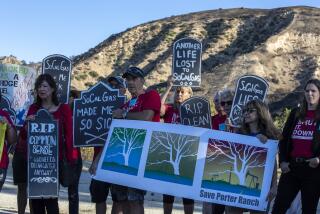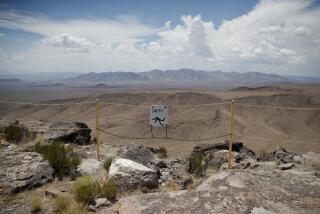Nader Group Cites Danger of Nuclear Plant Accident : Environment: Lack of a permanent disposal site results in insecure storage of spent fuel. No solution is likely before 2010.
- Share via
WASHINGTON — The likelihood of a major accident is increasing as the nation’s 113 commercial nuclear power plants continue to generate highly radioactive wastes that must be temporarily stored on site while Washington searches for a permanent repository, a consumer group warned Wednesday.
Because of technical difficulties and political resistance, the Department of Energy has not been able to provide the nuclear industry with a permanent disposal facility, despite a decade-long effort.
As a result, many commercial nuclear plants have run out of secure storage areas for spent fuel and are keeping such wastes in casks that rest on outdoor concrete pads surrounded by barbed wire.
The Energy Department is committed by legislation and by contracts with the nuclear industry to provide a permanent repository by 1998, but it conceded this month that the proposed Yucca Mountain site in Nevada cannot be ready until 2010, at the earliest.
In the meantime, the nuclear plants have become potentially dangerous “de facto long-term, high-level nuclear waste dumps,” the Washington-based Public Citizen consumer group said.
“The nuclear industry still does not know what to do with its radioactive garbage,” the group said in a report that characterized the 1980s as a “decade of decline” for the nuclear industry.
“Despite another 10 years of study, and the expenditure of over $2 billion, the U.S. is today further away from a nuclear waste disposal solution than it was a decade ago,” Public Citizen declared.
The group, founded as a nonprofit research and advocacy organization in 1971 by consumer advocate Ralph Nader, called the lack of a permanent disposal site an “intractable” problem.
The government’s attempts to find such a facility have been plagued by false starts and controversy for more than a decade.
In 1987, Congress finally decided to concentrate on the desert Yucca Mountain site, about 100 miles northwest of Las Vegas. But Nevada officials have resolutely resisted every attempt by Washington to put the depository in their state.
Last month, Nevada refused to give the Energy Department environmental permits that would have allowed digging of an exploratory shaft to test Yucca Mountain’s permeability and its ability to survive earthquakes and withstand heat generated by the wastes.
Deputy Energy Secretary W. Henson Moore said that the Justice Department will file suit against the state in January.
But, on Wednesday, Nevada Atty. Gen. Brian McKay moved first by filing suit against the federal government. McKay noted that the Nevada Legislature has passed two bills against the Yucca Mountain depository. The suit asks a federal court in San Francisco to declare the state action “a valid and effective notice of disapproval,” as provided under federal law.
As the state and federal standoff continues, highly radioactive wastes are accumulating at a rate of 1,800 to 2,000 metric tons annually, having grown 170% from 1980 to the end of 1988, the group said. The total now stands at 17,607 metric tons, it added.
It urged the government to close down all nuclear power plants “as soon as possible” and to redirect funds intended for the nuclear industry toward developing alternative sources of energy.
The nuclear industry just last week issued its own end-of-the-decade report in which it characterized the 1980s as “a decade of challenges met” and predicted growth during the 1990s.
The reports were issued at a time when Energy Department officials are putting the finishing touches on a major new conservation initiative, to be announced next month, that is spurred largely by the expectation of another energy crisis in the 1990s.
Energy officials have described the conservation initiative as a prerequisite to the adoption of a national energy strategy that the department is developing at President Bush’s direction.
More to Read
Sign up for Essential California
The most important California stories and recommendations in your inbox every morning.
You may occasionally receive promotional content from the Los Angeles Times.










